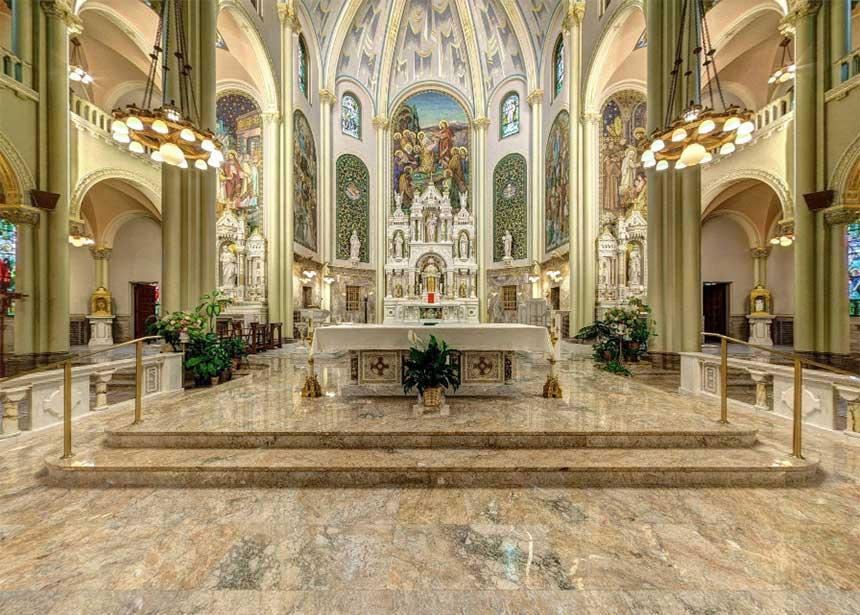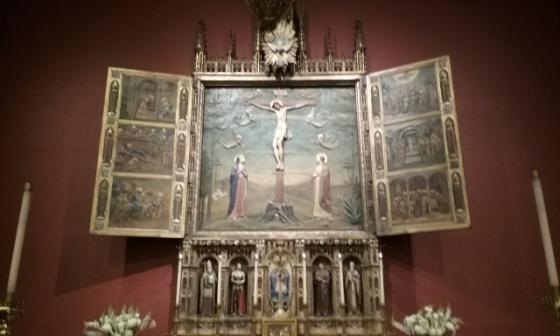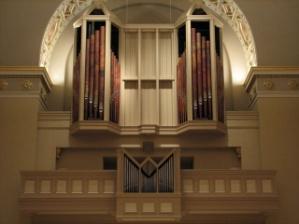Sinda Dux reports on the 2019 North Central Regional AGO Convention in Milwaukee June 16–19.
"A Great City on a Great Lake for some Great Music." It may be a long title but it certainly sums up Milwaukee, Wisconsin during June 16–19, 2019 for the North Central Regional AGO Convention. I had a wonderful time, listening to fabulous organists on marvelous organs, exploring Milwaukee for the first time, and, of course, talking to old and new friends.
The Convention began with a great concert by Jan Kraybill of Kansas City, who has played here in Lincoln several times. Her concert, "A Community of Voices," absolutely wowed the crowd with selections by J. S. Bach, Liszt, Tournemire, and Dupré, among others. The organ is a 1981 Casavant Opus 3493 3/35. St. Joseph's Convent Chapel is a stunning Romanesque Revival building with marble imported from 15 locations around the world and 115 stained glass windows from Innsbruck, Austria.
Monday began with Morning Prayer at All Saints' Episcopal Cathedral led by the Cathedral Choir, whose music ministry is offered twice weekly. The original organ was renovated in 1999 by the Schlicker Organ Company of Buffalo, New York. The 3-manual instrument, with added stops and ranks, was dedicated in 2002.
This Morning Prayer service was the first time I had ever sung The Lord's Prayer and The Apostles' Creed, each on one note. We also chanted a Venite, Te Deum, Suffrages, and Collects—a very interesting "high church" experience for me.
Three music companies, Hall Leonard, Cliff Hill Music, and MorningStar, presented music for the choral reading sessions which were enthusiastically received by the participants. It helps to have excellent accompanists!
After a box lunch, it was "back on the buses" to St. Paul's Episcopal Church to hear the winner of the RCYO Competition, which had taken place the previous Sunday afternoon. The winner and two runners-up were introduced and received enthusiastic applause. Winner Michael Terry Caraher is a junior at St. Olaf College in Northfield, Minnesota and an organ student of Dr. Catherine Rodland and voice student of Dr. Anton Armstrong.
His program was played on a Schantz 3-manual Opus 2307, 2011, with pipework by Hook and Hastings Opus 1187 from 1884, rebuilt in 1951 and 1970. Michael played Prelude and Fugue in C Minor, BWV 546, by J. S. Bach; The Resurrection by Larry King (my personal favorite); Musica Dominicalis: Moto Ostinato by Petr Even; and Piéce Héroĭque by Franck, all played wonderfully and earning Michael a standing ovation.
I loved this church because it contains original stained glass windows signed by Louis Comfort Tiffany. One such window is called Christ Leaving the Praetorium and is the largest stained glass window Tiffany ever made: 30 feet long, 24 feet high, and 2 inches thick.
Three excursions were offered for the afternoon: the Milwaukee Art Museum, the Harley-Davidson Museum, and Lakefront Brewery. I know some of you will be disappointed to read that I chose the most cultural of the choices, the Art Museum. I was told that several of those who went to the Brewery came back to the hotel with throbbing heads after tasting too many samples!
After dinner on our own and enjoying the exhibits, we boarded the buses for St. John the Evangelist Church, mother church of the Catholic Archdiocese of Milwaukee. Michael Hey, the concert organist, graduated in 2014 from the accelerated five-year degree program at The Juilliard School, receiving both his Bachelor of Music and Master of Music degrees in Organ Performance under Paul Jacobs. Since 2015 Michael has been the Associate Director of Music and Organist of St. Patrick's Cathedral in New York City where one of his first major tasks was to perform for the first U.S. visit of Pope Francis. No pressure!
Michael's program for the convention, played on a 2005 Nichols and Simpson 3-manual organ, included Widor, Ravel, Dudley Buck, Seth Bingham, Jonathan Dove, and Leo Sowerby.
And so to bed, to coin a phrase.
Tuesday I skipped the morning workshops and afternoon concerts and did a walking tour of downtown Milwaukee, seeing the original Pabst Brewery and Pabst Mansion, many Romanesque Revival, Greek Revival, and (my favorite) Art Deco beautifully preserved buildings, and a bit of the River Walk. I also went back to the Milwaukee Art Museum.
I rode a city bus to the evening convention supper, a fish fry in an ethnic Serbian neighborhood, and then to the absolutely incredible Basilica of St. Josaphat in an ethnic Polish neighborhood. As I was told, a cathedral belongs to a bishop and a basilica belongs to the Pope; the Pope has to okay the basilica and then okay the design. St. Josaphat has a very interesting history: the first building was deemed too small so the resident priest ordered that a new, larger church be built. He heard that the Post Office and Customs Building in Chicago was being torn down so he rented 500 boxcars to carry all the materials from that Chicago building to Milwaukee to build the new church. Much of the labor, unpaid of course, was by the congregation members. The cornerstone was laid in 1896 and the building finished in 1901. Even today the door knobs of the Basilica have the U.S. Treasury symbol on them from the original Chicago Post Office/Customs Building.
A most enchanting program was given by the Chant Claire (French for "clear sound") Chamber Choir; some selections were The Spheres by Ola Gheilo, Kyrie from Mass in Eb by Rheinberger, Ave Maria by both Holst and Biebl, the gorgeous Miserere Mei Deus by Allegri, a Bulgarian love song, Amazing Grace and Schenectady from The Sacred Harp, and O Day Full of Grace, arranged by F. Melius Christiansen. The reverb in that sanctuary was at least 7–10 seconds so it was a spiritual experience, certainly.
After the concert, everyone was invited to the undercroft to view the historical exhibits of the church and to play/hear the 1905 2-manual Kimball organ, restored by Buzard Pipe Organ Builders.
The last day of the convention, Wednesday, was really, really busy. It began with a regional breakfast meeting in the hotel atrium during which regional officers, chapter officers from each state in the region, and convention planners were recognized.
The Chapel of Christ Triumphant at Concordia University Wisconsin, on the shores of Lake Michigan, was the setting for the morning's Hymn Festival. I had total cognitive dissonance all through the worship. The word "Concordia" made me know that this was a Lutheran Church-Missouri Synod college; yet the Chapel contained a huge crucifix, side altars, kneelers, and large Stations of the Cross! Afterwards I found out that the college used to be a Catholic school that went bankrupt and was bought by the LCMS which apparently just decided to leave the Chapel as it was except, so I was told, that the huge stained glass window showing Christ Triumphant used to show the Assumption of Mary.
John Behnke, who has also played here in Lincoln for the Lincoln Organ Showcase, was organist accompanied by a trumpeter, The Milwaukee Handbell Ensemble, and the Festival Chorus. Marvelous arrangements of familiar hymns and the outstanding organ playing by Behnke made this event very special. The organ is a 3-manual Steiner-Reck, Opus 88, 1989.
A box lunch on the bus (not my favorite way of eating a meal) was followed by a stop at Sts. Peter & Paul Catholic Church back in Milwaukee for a recital by Jillian Gardner, a Baylor University (Waco) graduate and a member of the AGO Young Organists. She played on a 2-manual Robert Sipe organ Prelude and Fugue in E Major, BWV 566, by J. S. Bach; 3 Inventions from the School of Trio Playing by Bach/Max Reger; Fugue in G Minor by A. L. Barnes; a lovely Fountain Reverie by Percy Fletcher; Passacaglia from Sonata 8 by Rheinberger; and Jillian's own transcription of six songs from Act III of The Sleeping Beauty by Tchaikovsky.The transcription proved to be the audience favorite of Jillian's recital.
Then on to hear the Casavant Opus 2479, 2013, 3/36 at Mount Carmel Lutheran Church ELCA played by Elisa Bickers of Prairie Village, Kansas. She specializes in the organ music of Olufela Sowande (1905–1987), a Nigerian composer who moved to the United States and whose works were inspired by African folk song, Anglican traditions, and American jazz. Elisa also played Nicolaus Bruhns, Cecilia McCowall, Vierne, Grieg, and Mendelssohn.
Our buses took us back to the hotel where we could freshen up, rest, maybe change clothes, and then attend the banquet in the hotel atrium. The last event of the convention was held at the Catholic Church of the Gesu on the campus of Marquette University. Another gorgeous church sanctuary and an unbelievably beautiful and intricate concert by Lynne Davis, Professor of Organ at Wichita State University School of Music in Kansas. She spent from the late 1970's to 2006 living in France and actually became a French citizen, having married Frenchman and Chartres International Organ Competition founder Pierre Firmin-Didot. Following the immense success of the American Alain Festival, which she organized at Wichita State University to celebrate the 100th Anniversary of the birth of Jehan Alain, she was awarded as a French citizen the Chevalier de l'Order des Arts et des Lettres from the French Ministry of Culture and Communication in 2012. Lynne's selections were by Demessieux, Pierre Du Mage, Franck, Vierne, Jehan Alain, Widor, and Joseph Bonnet. The 4-manual organ is described thusly: W. W. Kimball Company, 1890's; Kilgen Organ Company, 1955; Schantz Organ Company, 2010.
The 2020 National AGO Convention will be in Atlanta, Georgia. The 2021 Regional AGO Convention will be July 4-7 in the Twin Cities of Minnesota.














